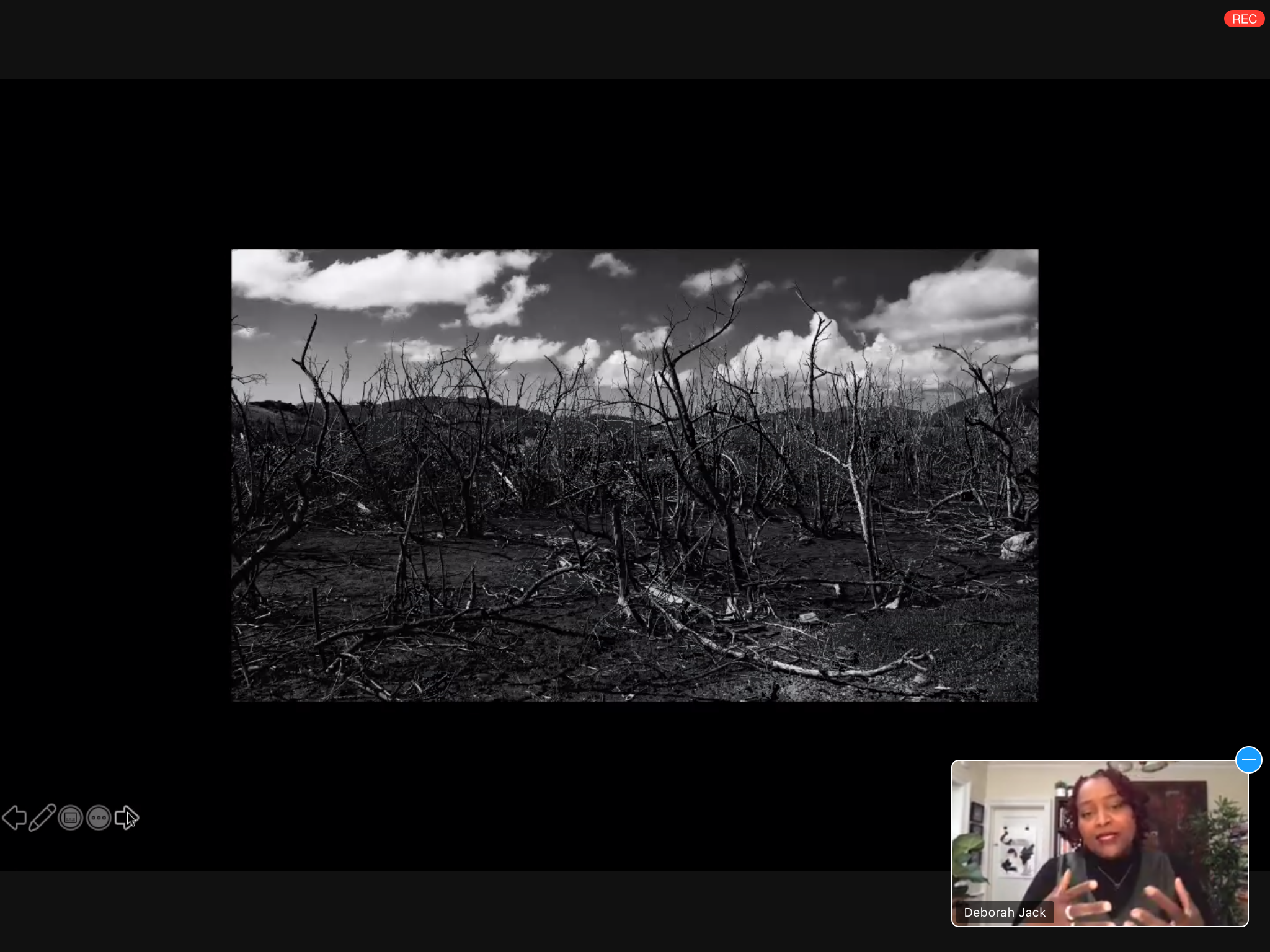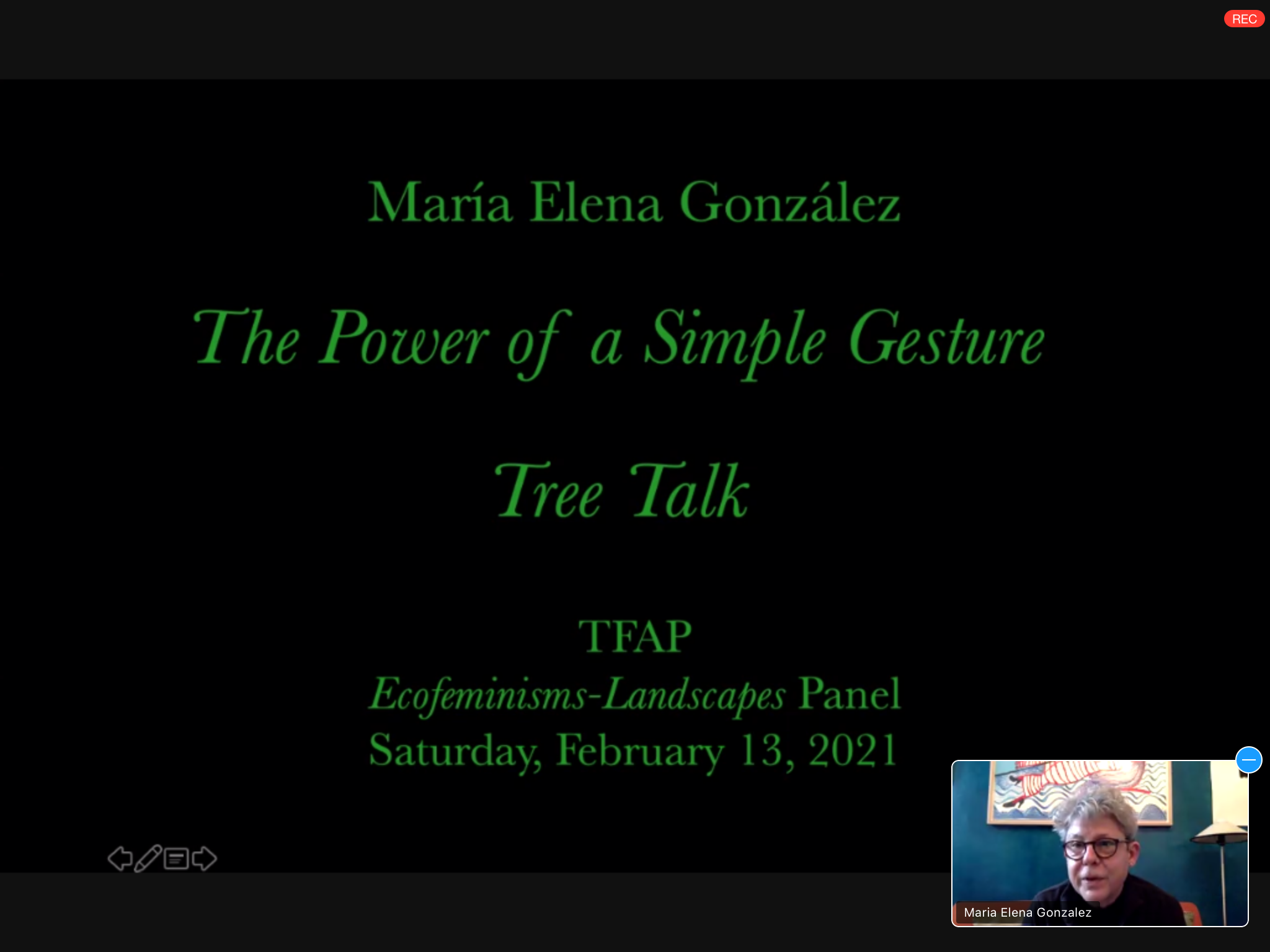
CAA 2021: 89 Panels Focused on the Climate Crisis
Submitted by Sue Spaid
According to the official conference schedule, CAA 2021 hosted 89 panels over 4 days that featured nearly 325 presenters addressing issues “including but going beyond eco-art and eco-criticism, with a special focus on climate justice and intersectional thinking as priorities.” I have attended conferences where it was imperative to read presenters’ papers in advance, but this was my first conference where I was expected to watch three to four 15-20 minute videotaped presentations in advance of each 30-minute panel discussion in order to intelligently discuss presenters’ talks. Crazier still, pre-recorded presentations came online less than a week before the first day, leaving those attendees particularly interested in the climate crisis just 168 hours to watch 108 hours of pre-recorded content to prepare for 89 half-hour sessions. For good, several climate crisis panels were booked simultaneously, so one need only prepare for the favored theme. Luckily, the pre-recorded talks and recorded discussions remained available through March 15, which meant that if one devoted five hours a day for the remaining 30 days, one could still catch 153 hours of recorded content. I did my best to view as much content as possible. According to CAA’s post-conference survey, the average attendee checked out the recorded talks associated with two panels.
Elsewhere I’ve characterized how centuries of colonialism aggravated species extinction, vulnerable essential workers, and the negligence that spurred the Black Lives Movement. Not only did numerous panels tie climate justice to the legacy of colonialism, in particular the violence harnessed to sustain environmentally-insensitive extractive industries; while others credit climate change with instigating radical pedagogies, cultural sustainability, multispecies co-authorship, intersectional approaches to ecology, geo-trauma, and mourning as a means of coping with ecological grief. Given the role played by place in shaping local cultures, beliefs, and values, it’s imperative that societies recognize how degraded environments destabilize cultural identities. Such a diverse range of panels painted climate justice as both product and a cause of widespread social ills.
Land acknowledgment statements typically honor indigenous peoples’ territories related to the in-person conference’s location. The first CAA 2021 panel I attended encouraged listeners to post the names of Indian tribes whose unceded lands they occupied, which truthfully inspired me for the first time in my life to investigate the Native Americans inhabiting Houston, my parental home since 1977. I eagerly typed in “Akokisa, a tribe associated with the Atakapa Indians,” known as the Atakapa-Ishak Nation. This was the first indication that a zoom meeting could prompt locals to discover local lore.

This conference provided an opportunity to explore the wealth of contemporary art being created by artists of Native American descent, such as David Boxley’s Tsimshian imagery, Dyani White Hawk’s paintings and beadwork inspired by Lakota quillwork, Oscar Howe’s dynamic casein and tempera paintings, James Johnson’s Tlingit carvings and dynamic skateboards, Courtney Leonard’s ongoing Breach project inspired by the Shinnecock Nation’s ancestral lands near Montauk, and Hulleah Tsinhnahjinnie’s digital art. Participating art historians/curators researching indigenous artistic practices included Yve Chavez, Eva Mayhabal Davis, Kendra Greendeer, Frances Holmes, Madison Treece, and Stephanie Sparling Williams. Participants in Aram Han Sifuentes’ workshops have created over 2500 banners that she routinely lends to protesters marching to protect Native American ancestral lands.
Of special interest was a panel entitled “Artworks of the Future/Artworks for Jellyfish,” during which artists Ted Hiebert and Ryuta Nakijima, artist/ornithologist Silas Fischer, and art historian Amanda Boetzkes discussed bird wellbeing, songbird “consent,” planetary flesh-relations, co-embodiment, the loss of the other vs. extinction, and artworks created by cephalopods (cuttlefish, octopuses, and squids), whose “adaptive coloration” capacities enable them to blend in with computer-generated images of artworks. Another artist who mixes science and art is Xiaojing Yan, who uses a diverse range of natural materials, including pine needles, freshwater pearls, lingzhi mushrooms, and cicada exoskeletons. To create her living sculptures, she puts wood chips and lingzhi spore mixtures into a mold and then removes the mold so the mushrooms can continue growing in a greenhouse.

One of the sessions whose artworks especially addressed climate change was “During the “From Wheatfields to Ecosophy: A Consideration of Women Artists in the History of Climate Change” session, which Cynthia Veloric who invited me to be the discussant organized. Diane Burko surveyed her paintings that characterize climate change’s effects over a century. Christina Catanese introduced “The Tempestry Project” for which dozens of knitters registered daily temperature fluctuations in colored yarn, while Bonnie Peterson presented her elaborate embroideries that depict environmental data. Jenny Kendler discussed Birds Watching (2018-2019), which captures the eyes of 100 U.S. climate-threatened species, while Daniela Naomi Molnar shared her watercolor paintings that map climate change reshaping our planet.
The panel “Aviva Rahmani: From Ecofeminism to Climate Justice” highlighted Rahmani’s oeuvre beginning with her carrying/caring for an object for a week as an undergraduate up through The Blued Tree Symphony (2015-present). MOCA Los Angeles curator Rebecca Skafsgaard Lowery highlighted her early performances, such as The Pocket Book Piece (1969), during which participants described their association to purse items; Smelling (1972), for which blindfolded Cal Arts students sniffed one another to try to identify each other by scent, and the collaborative activist performance Ablutions (1972), which took place in Laddie John Dill’s studio. For this feminist artwork, Judy Chicago, Suzanne Lacy, Sandy Orgel, and Rahmani choreographed performers seated in metal bathtubs, filled with eggs, animal blood, and clay; while the audience heard various speakers personal accounts of rape. Curator Monika Fabijanska remarked that Rahmani was among the first to connect the rape/assault of women to routine violations/abuses of nature. Chava Maeve Krivchenia discussed the results of Rahmani’s having painted boulders alongside a public causeway blue to draw attention to the stagnant water below. Despite having been officially invited by a curator to create this public artwork, an islander subpoenaed her to wash off the paint. With help from the local Garden Club, her “wash-in” became a “teach-in” for passersby. Thanks to her actions, the causeway was opened enough to allow for tidal flushing, thus restoring 27 acres of coastal wetlands. Finally, copyright lawyer Gale Elston explained the significance of Rahmani’s exploration of the limits of VARA, the law protecting artists against artwork damage/removal. To protect forests from fossil fuel development, she painted blue sine waves on trees and copyrighted hundreds of “tree-notes” in an aerial score in the paths of natural gas pipelines as art.

The rare speaker focused on surface water, Omar Olivares Sandoval’s “Critical Geologies: Contemporary Geoaesthetic Research of Mexico City Lakes” addressed the idealization of Mexico City as a lake. TFAP Ecofeminisms 4, one of several affiliated panels, featured a “Waterways” session, during which Gina McDaniel Tarver discussed Alicia Barney Caldas’ installation Río Cauca (1981-1982), which featured 3 transparent tanks of river water embedded with 15 test tube samples. During the “Art and Ecology in the Middle East and West Asia” panel, Nat Muller discussed Jumana Manna’s Wild Relatives (2018). This “sci-fi” documentary captures the efforts of farmers inhabiting Lebanon’s Beqaa Valley to replicate Aleppo’s seed bank, which had closed in 2012 as a result of the Syrian Civil War, with heirloom seeds acquired from Svalbard’s Global Seed Vault.
No discussion of climate justice would be complete without remarking on ways to overhaul the capitalocene, which many consider the underlying source of all our ecological ills. Keynote speaker Salah Hassan spoke persuasively of the need for art history to reposition the global south to the center to shift the very paradigms that sustain inequalities stemming from capitalism’s history of racism and slavery. Acting as the discussant for “Art and Ecology in the Middle East and West Asia,” T. J. Demos noted the transition from “petro-affectivity,” such that petrodollars that once greased the Iranian art world, affording artists distinct advantages; now exhibit “necro-affectivity.” For Demos, Muller’s paper muses on “interrogations of precarity and terminal endings visited upon refugee seeds as much as refugee people as investigated in Manna’s slow cinema of slow violence with its somber meditations on the sepulchral afterlife of a culture’s biogenetic heritage as it sits in the seed vault that is itself threatened by the catastrophic climate breakdown and melting permafrost resulting from that earlier fossil capital modernity.”
Note: ecoartspace members noted in bold